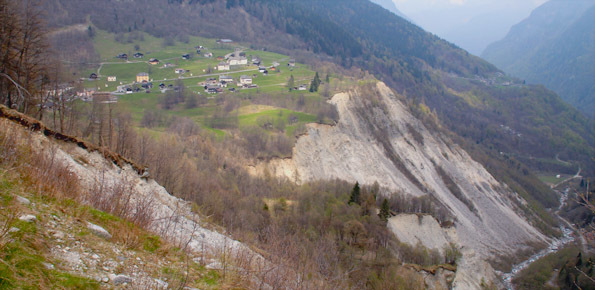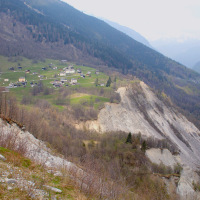Effects of climate change on landslides
Impact of climate changes on landslide occurrence, frequency, hazard, and risk

Worldwide, landslides pose a serious threat to the population, causing fatalities, widespread damages, and significant economic losses. Different phenomena influence the stability of slopes and can cause landslides, among which the main factor is rainfall. Rainfall is strongly controlled and influenced by climate and its variations. Therefore, it is to be expected that climate changes influence slope stability at different temporal and geographical scales.
In the last years, an increase in the average global temperature is widely acknowledged (according to the Intergovernmental Panel of Climate Change, Global warming is “unequivocal”). Consequently, the frequency and the intensity of high intensity rainstorms is also increasing, although in places the average yearly cumulated precipitation is not showing significant changes.
The assessment of the effects of climate change on the natural environment challenges the scientific community, with a number of scientists dealing with landslides and climate change. Anyhow, landslide hazard and risk are seldom considered in the policy debate on climate change. Moreover, the effects of global warming, and the related changes in climate, on landslides (as on other geo-hydrological hazards) remain difficult to quantify, and to predict.
In order to understand and quantify how climate variables and their variability affect landslides and other geo-hydrological hazards, a holistic and multidisciplinary approach is necessary. Several scientific fields e.g., climatology, atmospheric physics, hydrology, hydraulics, geology, geomorphology, hydrogeology, geotechnical engineering, soil science, environmental science, and also economics and social sciences, must to be considered and joined.
This focus aims at verifying these assumptions, and at proposing new tools and methods for the evaluation, at regional scale, of the impact of climatic and environmental changes on landslide occurrence, hazard, and risk. Starting from a critical review of the scientific literature, first a worldwide analysis on past and expected changes in landsliding due to global changes is performed. Then, the spotlight is focused on Italy, with particular considerations on landslide hazard and risk. Finally, different quantitative, objective, and reproducible methods for a regional analysis are presented, with the aim of: (i) evaluating past variations in rainfall-induced landslides related to changes in rainfall events, in the 20th century; (ii) evaluating the expected variations in rainfall-induced landslides according to future climate projections, under several scenarios; and (iii) estimating the influence of observed and expected land-use / land-cover changes on the occurrence of landslides.
Results
Quantitative and reproducible methods for the evaluation, at a regional scale, of the impacts of climate change (in particular of variations in rainfall patterns) on landslide occurrence were proposed. The methods were applied in Calabria region, southern Italy, were long series of rainfall measurement and information on landslides were available. More in details, correlations
between landslide occurrence and climate variables were defined. Then, the correlations were joined with mid- to long-term climate projections (provided by the Euro-Mediterranean Centre for Climate Change) to define future scenarios of landslide occurrence. Results outlined an increase in landslide occurrence in most of Calabria, and a significant increase in the number of expected landslide with the more pessimistic scenario, in the future period 2036–2065.
Moreover, a global map of the projected impact of climate change
on landslide activity and abundance was realized. The map, which as preliminary, first attempt to tackle the problem, was published in 2016 and in 2017 was included in the European Environment Agency report on climate change adaptation and disaster risk reduction in Europe.
To know more
Gariano S.L., Guzzetti F. 2016. Landslides in a changing climate. Earth-Science Reviews, 162, 227-252. https://doi.org/10.1016/j.earscirev.2016.08.011.
Gariano S.L., Guzzetti F. 2021. Mass-Movements and Climate Change. In: Reference Module in Earth Systems and Environmental Sciences, 13 pp., https://doi.org/10.1016/B978-0-12-818234-5.00043-2.
Schlögel R., Kofler C., Gariano S.L., Van Campenhout J., Plummer S. 2020. Changes in climate patterns and their association to natural hazard distribution in South Tyrol (Eastern Italian Alps). Scientific Reports 10(1), https://doi.org/10.1038/s41598-020-61615-w.
Gariano S.L., Petrucci O., Rianna G., Santini M., Guzzetti F. 2018. Impacts of past and future land changes on landslides in southern Italy. Regional Environmental Change, 18, 437–449. https://doi.org/10.1007/s10113-017-1210-9.
Gariano S.L., Rianna G., Petrucci O., Guzzetti F. 2017. Assessing future changes in the occurrence of rainfall-induced landslides at a regional scale. Science of The Total Environment, 596–597, 417-426. https://doi.org/10.1016/j.scitotenv.2017.03.103.
Picarelli L., Comegna L., Gariano S.L., Guzzetti F., Mercogliano P., Rianna G., Santini M., Tommasi P. 2016. Potential climate changes in Italy and consequences on land stability, in Ho K., Lacasse S., Picarelli L. (eds.), Slope Safety Preparedness for Impact of Climate Change, pp. 151-198, CRC press, ISBN 9781138032309.
Gariano S.L., Petrucci O., Guzzetti F. 2015. Changes in the occurrence of rainfall-induced landslides in Calabria, southern Italy, in the 20th century. Nat. Hazards Earth Syst. Sci., 15, 2313–2330. https://doi.org/10.5194/nhess-15-2313-2015.




 Contact person: stefano luigi gariano -
Contact person: stefano luigi gariano -